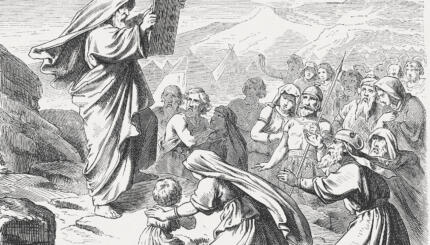How did the classical rabbis imagine God? Rabbinic literature and archaeological sources reflect a good amount of diversity. Rabbinic sources occasionally restrict the use of graphic images of God and are occasionally more permissive; archaeological sources sometimes include images, sometimes avoid images, and sometimes the archaeological record shows the images destroyed. Eventually, all physical representations of God were forbidden.
There was no such reticence, however, when using figurative language. Indeed, the literature known as midrash–which interprets and re-uses Scripture to express its own theological concepts–is replete with a wide range of images of God. In particular, the rabbinic parable presents God in many striking and complex ways.
God as King
Without question, the dominant image of God, especially in the later rabbinic parables, is God as King. Many of the king parables distinguish the Eternal King from mortal kings or create an unexpected perspective on the relationship to the king. As if to create a justification for their own use of human images for God, this early mashal (parable) sets the underlying theology of associating God with a human character in God’s own mouth.
"A parable to a king who took a walk with a tenant farmer in an orchard, and the farmer tried to hide from him. The king said to the farmer, ‘Why are you hiding from me? I am just like you.’ The Holy Blessed One, seeing the righteous trembling before Him, says to them, ‘I am just like you.’" (Sifra Behukotai 3:3).

Help us keep Jewish knowledge accessible to millions of people around the world.
Your donation to My Jewish Learning fuels endless journeys of Jewish discovery. With your help, My Jewish Learning can continue to provide nonstop opportunities for learning, connection and growth.
"I am just like you," is, of course, hyperbole. Average people are clearly not like kings, human or divine, and yet, the parable affirms to the reader that people should be able to relate to God without trembling.
Another early king parable presents God’s role as king as being subject to Israel’s approval. God had to earn the title.
"Why are the Ten Commandments not recited at the beginning of the Torah? It is like [the story of] a king who came into a city and said, ‘I will be king over you.’ And they said to him, ‘You haven’t done anything for us that [says to us] you should be king.’ What did the king do? He built walls and aqueducts and fought wars. He said ‘I will be king over you,’ and they said ‘Yes! Yes!’ Similarly, the Omnipresent took Israel out of Egypt, split the [Red] sea, provided the manna and the quail [to eat in the desert], and fought the war with Amalek. He said ‘I will be king over you,’ and they said ‘Yes! Yes!’" (Mekhilta Bahodesh 5).
God is not King as a result of being the Creator. God is only King as a result of human acclamation.
God as the Knowing Creator
Of course, God is also the Creator, but the focus of this image is not simply that the creator controls or owns the creation. Rather, God is a knowing Creator, who has a deep understanding of creation.
"It is written, ‘Woe unto them that seek deep [places], to hide their counsel from the Lord’ (Isaiah 29:15). R. Levi said: This is like [the story of] a city planner who built a city with [secret] chambers, canals, and caves. Later he became a tax-collector, and the inhabitants of the country hid from him in those chambers and caves. Said he to them, ‘It is I who built all these chambers and caves; to what purpose then is your hiding?’ Similarly, ‘Woe unto them that seek deep [places], to hide their counsel from the Lord’…" (Genesis Rabbah 24:1).
This parable describes God’s dual nature, both as Creator and as the One who collects what is due. While Jews living under the Roman Empire might be successful in hiding assets from confiscatory taxation, they would not be able to hide their thoughts from God.
God as Master of Life and Death
Another image, common in the liturgy as well, is God as the master of life and death. Strikingly, the images which refer to this aspect of God do not reflect positive characteristics. A mashal of R.Hanina b. Papa likens God to a hunter who holds a bird in his hand. The hunter met a man and asked him: "Is this dead or alive?" "If you wish, it is alive; and if you wish, it is dead," was the reply (Genesis Rabbah 19:11). Imagining God as the capricious hunter who could, with a light squeeze, prove the man’s guess wrong, can be seen as a reproach.
God as Parent
Rather than maintaining simple, stereotypical images, like many in the liturgy, the mashal recognizes the complexity of the human relationship with God, transcending the stereotypical depiction by creating complex characters who reflect a complex relationship. God is described as a parent who cares for the children and also punishes them.
In a widely known parable, God goes to extreme lengths to protect his son.
"It is like [the story of] a person who is traveling. He had his son in front of him until brigands came, so he put him behind him. A wolf came up from behind, and he put him in front. Brigands came from in front and wolves from behind, so he carried him. The son was hot, so he provided shade with his cloak. He was hungry; he fed him. He was thirsty; he gave him drink" (Mekhilta Beshallach 4).
An almost identical parable, however, appears in Lamentations Rabbah 2:2, except when he puts the child on his shoulders, the child poops on the father. The father casts the child to the ground. The image of God as a frustrated and angry parent may not be comforting, but, in the context of the mourning in the book of Lamentations, Israel’s sins are seen as the natural acts of a child, and God’s punishment as an emotional overreaction.
God as Kohen
In antiquity, the (levitical priest) was known among the people not for his role in the Temple cult (which had been abandoned after the destruction of the Temple) but for his avoidance of impurity. So when God is imagined as a kohen, a source of impurity represents whatever God dislikes.
A simple application of this image imagines God as a kohen who is very careful about purity law and who gives a loaf of bread (the soul) to another kohen (a person). The second kohen must return the loaf in a state of purity, or the careful kohen will "throw it away in front of [his] face" (Leviticus Rabbah 18:1).
But in another example, despite God’s distaste for that which is impure, God tolerates exposure to impurity in order to prevent shame to Moses.
"For whose sake did God reveal God’s self in Egypt? For the sake of Moses. R. Nissim compared this to a kohen who had a fig orchard in which there was a ritually impure field. When he wanted some of the figs, he told one of his men to go and get some from the tenant farmer; but the tenant farmer refused. So the kohen said: ‘I will go to the orchard myself!’ His men said: ‘Will you go to an impure place?’ He responded, ‘Even if there are a hundred different kinds of impurity, I will go, so that my messenger may not be put to shame.’"
"So when Israel was in Egypt, God said to Moses: ‘Come now and I will send you to Pharaoh’ (Exodus 3:10), so Moses went. [But Pharoah] asked:
‘Who is the Lord, that I should obey him?…I don’t know the Lord’ (Exodus 5:2)…Then God said: ‘I will go to Egypt Myself.’…God’s angels said: ‘Will you go to an impure place?’ God replied, ‘Yes, so that My messenger Moses may not be put to shame’" (Exodus Rabbah 15:19).
It is striking that this parable presents God as a kohen who willingly encounters ritual impurity. This particular example is yet another example in which the typical assumptions about the human image of God are reversed or given a twist. Other parables present God as a teacher who does not practice what he preaches or as a judge who breaks the rules of judicial procedure.
By couching the image of God in familiar or predictable characters, the rabbinic preachers who created these parables sought to draw their audience in; by transcending the obvious and typical characterizations, perhaps they sought to make their audience think about God a little more carefully.


